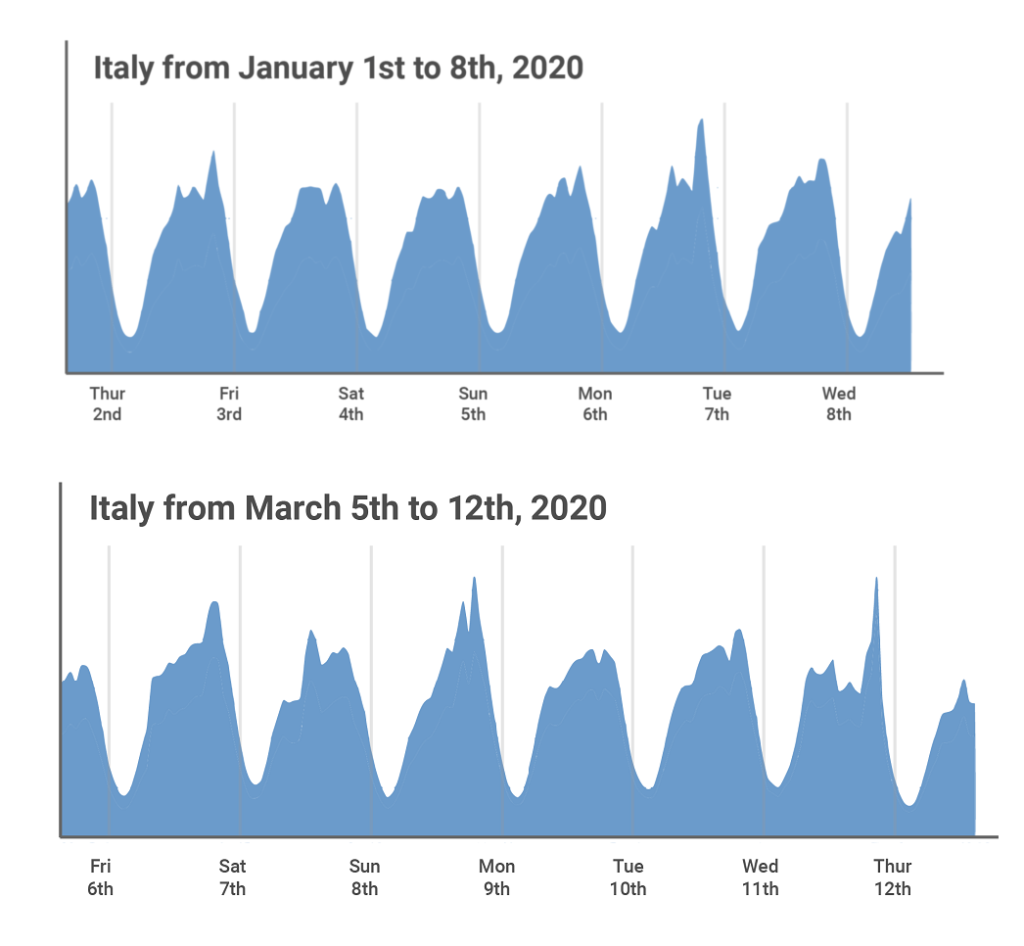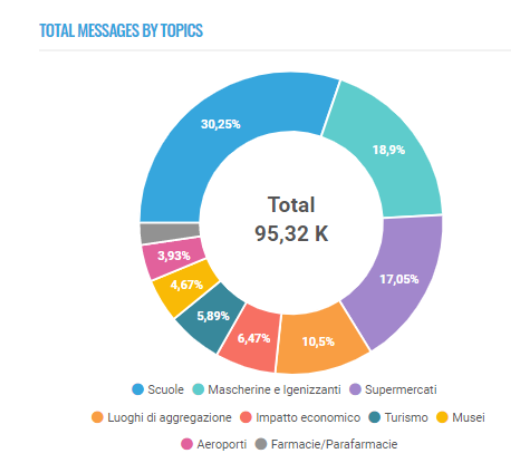A first point on the impact of Covid-19 between e-commerce and media

The health emergency we are going through imposes a real social control, which affects everyone’s behaviour and habits.
Theeffects on the market, on consumption,on communication channels have beenimmediate, and their observation is beginning to take hold.
Inthe future we will not lack the time and attention to understand the phenomenonand analyze it in depth; for the moment we can limit ourselves to studies andresearch that give us a global,panoramic, overview of the situation.
Sowe have collected the most interesting data and numbers that have emerged sofar on the impact of the health emergency on the world of communication, the digital and that sector linked to theonline, the e-commerce.
Wealso take this opportunity to anticipate that we are conducting our analysis of email flows sent through MailUp:a study that we will share with you as soon as possible, to help us understandhow the email ecosystem is behaving in this time of emergency.

From developing integrations to strategic support, from creating creative concepts to optimizing results.
Internet traffic trends in Northern Italy
Thestudy was conducted by the American company Cloudflare, which analyzed the behaviors of the web and verified howtraffic changed with the onset of the coronavirus emergency.
Thestudy was conducted (in addition to Seattle and South Korea) on North Italy, giving us a picture inwhich Internet traffic is grown by morethan 30% in the comparison between two periods: 1-8 January 2020 and 5-12March 2020. The increase is recorded at all hours of the day and night.

Going deeper, traffic is increased early in the morning compared to the beginning of January, when the upward curve began rapidly at 9.00 a.m. and reached its daytime peak around 2.00 p.m. In the middle of an emergency, traffic reaches its peak at 9.00 a.m.
Thestudy also focuses on changes in the way people use the Internet:
- The traffic on messaging systems has increased from 1.3 to 3 times compared to normal use
- Video streaming has almost doubled
- People access news sites with an increase ranging from 30% to 60%
- The use of online games records a +20%.
The use of data to combat the emergency. News from Italy:
› The government will use big data in the coronavirus emergency. Wired tells us, according to which a task force is being set up within the Ministry of Innovation, which will entrust the University of Pavia with research based on Facebook data (preserving privacy)
› The study Covid-19 & Mobility has tried to find out whether the Italians are really staying at home. Two professors in Statistics at the University of Bergamo have published it, who have exploited the geolocation parameters of smartphones (protecting the anonymity of people) to show that, after the first days of compliance with the rules, the people who move have increased dangerously.
The impact on e-commerce
Asyou can imagine, e-commerce has received a very strong boost from the health emergency. To make a firstpoint was Inmediato Mediaplus, which highlights how the values of e-commercehave registered a positive trend since the beginning of the crisis, witha peak in the period between 8 and10 March.

This is instead a chart that proposes a comparison between February 1-March 10 2019 and the same period of 2020. The trend did not undergo major changes until February 27, and then took off from March 6.

Xingu’s study wondered how much this social change impacts consumption and some types in particular. As perimeter, more than 80 brands have been chosen relating to 5 categories: Grocery, Games and Toys, Books, Wellness & Pharma, Kitchen Appliance and Design.
Theperiod of time taken into consideration runs from 16 February (date on which there were no cases yet) to 14 March, with particular attentionto the week of the lockdown (8 to 14 March).
Inthis graph we find the trend of displaying the pages for the categoriesanalyzed:

The peak of the week 1-7 March is evident for almost all sectors, with the exception of Games and Toys, whose rise continues in the following weeks.
Hereis the chart with the sales trends:

What happens on social networks?
Asalways, social media are the places where discussion on one side andinformation onthe other run the most (remaining the privileged means of circulating news,true or false).
Blogmeteranalyzed the conversations from Facebook, Instagram, Twitter, YouTube, blogs,news sites, which – in the period from 20 to 27 February – contained both thekeyword Milan andthat Coronavirus (includingits different declinations, COVID19, corona virus, forexample).
FromFebruary 20 (the day before the news on the first Italian coronavirus casespread) to February 27, there were over 153,000 conversations that met therequirements above and generated almost 5 million interactions. The peak of conversations occurredon the days between Sunday 23 andMonday 24 February, when the measures aimed at limiting the spread of thevirus (closure of schools and meeting places) were disseminated andcommunicated.

While most conversations were concentrated between Facebook and Twitter, the peak of engagement was YouTube, thanks to the fundamental contribution of videos published by newspapers and online magazines.
Interestingdistribution by topic:

We understand how the three most discussed topics are those with the greatest impact on people’s daily lives (school, masks, supermarkets); on the contrary, the issues with a lower impact on everyday life (the consequences on the economy and tourism) are more peripheral.
However,if we consider the distributionover time, we discover that the school and masks and sanitizing themes havepeaked in the first two days since the beginning of the emergency;conversations focused on economic issues rose to prominence starting on Mondayand Tuesday, when attempts were made (only momentarily) to put the alarm offthe early days.
What social platforms are doing:
› TikTok and Facebook take action against fake news about Coronavirus
The World Health Organization, the agency of the United Nations organization specialized in public health, has officially opened its TikTok channel to deal with fake news about Coronavirus. The launch of this account aims to counter the outbreak of the disinformation that is circulating on social media, in particular Facebook, Twitter and TikTok. Facebook, in the wake of Twitter’s “harmfully misleading” project, has announced its commitment to limiting and banning advertisements that mention “Coronavirus” (to intervene on the spread of self-styled cures and prevention).
› Facebook imposes a block on advertisements for the purchase of masks.
To avoid speculation about Covid-19, Facebook has also chosen to ban advertisements for products for the prevention and treatment of the virus, such as medical masks. Similarly, in the near future, the platform is committed to closing Coronavirus-themed groups, with the aim of curbing the spread of panic and fake news.
Facebook and Instagram have also introduced notifications that refer to information conveyed by the World Health Organization, the agency of the United Nations organization specializing in public health.
In addition, Facebook has introduced the Business Resources Hub for users, with the aim of supporting small and large businesses in carrying out daily tasks that can be safely carried out from their homes.
Upcoming: our study on the progress of the email channel
Assaid, with this post we wanted to put together some numbers and results relatedtothe incidence of the health emergency onsome key areas of the digital world.
Weanticipate that we are analyzing the sendingflows from MailUp in recent weeks, so as to return a useful picture onthe impact of the health emergency and the lockdown on companies ‘ Email Marketing strategies.